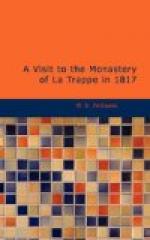The Abbe de Rance became a Monk of the Benedictin order of La Trappe, in 1660, and his conversion was attributed to a lady whom he tenderly loved. They had been separated for some time by her parents; she having written to him to remove her for the purpose of becoming united in marriage, he set off, but, during his journey, she was seized with a fever and died. Totally ignorant of the circumstance, he approached the house under cover of the night, and got into her apartment through the window. The first object he beheld was the coffin which contained the body of his beloved mistress! It had been made of lead, but being found to be too short, they had, with unheard of brutality; severed her head from her body! Horror-struck with the shocking spectacle, he, from that hour, renounced all connexion with the world, and imposed upon himself the most rigid austerities, which he continued until his death, forty years after.
When M. de Rance undertook the superintendance of the Monastery, it exhibited a melancholy picture, of the greatest declension, and it is curious to peruse the steps by which he effected so wonderful a change;[2] and how men could ever feel it either an inclination or a duty to enter upon a mode of life so different from the common ways of thinking or feeling.
[Footnote 2: Reglements de L’Abbaye, La Maison-Dieu Notre Dame de La Trappe, par Dom. Armand de Rance.]
The Monks of La Trappe were not only immersed in luxury and sloth, but were abandoned to the most scandalous excesses; most of them lived by robbery, and several had committed assassinations on the travellers who had occasion to traverse the woods. The neighbourhood shrunk with terror from the approach of men who never went abroad unarmed, and whose excursions were marked with bloodshed and violence. The Banditti of La Trappe was the appellation by which they were most generally distinguished. Such were the men amongst whom M. de Rance resolved to fix his abode; all his friends endeavouring to dissuade him from an undertaking, they deemed alike hopeless and dangerous.
“Unarmed, and unassisted,” [3] says his historian, “but in the panoply of God, and by his Spirit, he went alone amidst this company of ruffians, every one of whom was bent on his destruction. With undaunted boldness, he began by proposing the strictest reform, and not counting his life dear to him, he described the full intent of his purpose, and left them no choice but obedience or Expulsion”.
[Footnote 3: The work from which I have taken this, is a translation by Mrs. Schimmelpenninck of Dom. Claude Lancelot’s Narrative, published in 1667. The present regulations not differing from the former, I have extracted some of the most important.]




